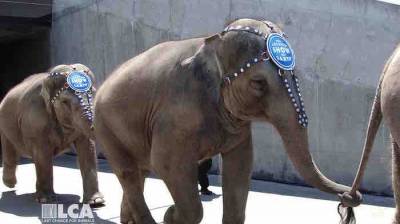LCA Blog
5 Reasons Elephants Don’t Belong in Captivity
Flash back to Easter Sunday, 1882.
At Madison Square Garden in New York City, P.T. Barnum introduced Jumbo, a large African elephant, into his act. Over the next 134 years, elephants became synonymous with the circus.
Flash forward to May 1, 2016.
After decades of protests by LCA and other groups, Ringling Bros. took a giant Pachyderm step in the right direction by permanently removing elephants from their circus acts. Ringling Bros. gave circuses around the world a loud wake-up call.
What’s wrong with elephants in captivity?
Over the last decade, scientists have discovered that elephants are among the most intelligent animals on the planet. Researchers have witnessed elephants using teamwork to find food, making tools to shoo flies, and expressing a range of emotions from triumph to grief.
It’s not all that surprising. Elephants and humans have evolved on a parallel path for millions of years. When you really think about it, confining elephants makes about as much sense as displaying a human in the zoo.
1. Zoos and circuses can’t come close to providing the social environment that elephants need. In the wild, elephants have large extended families and a complex web of social relationships. Mothers and children spend their entire lives together. But zoos and circuses rip families apart, stealing babies right from their mothers.
2. Confinement puts elephants in physical peril. Elephants have evolved to a lifestyle of free movement over vast home ranges. Tight quarters lead to obesity, deadly foot disease and arthritis.
3. Confinement causes psychological distress In 2013, a groundbreaking study of elephants in zoos found that the majority of these animals demonstrated repetitive behaviors such as swaying and pacing, indicating mental disturbance.
4. Circus trainers use bullhooks to control elephants through dominance, fear and pain. Trainers prod or strike elephants with bullhooks to teach them to perform tricks. Even the “gentlest” elephants and the most skilled trainers have had numerous, documented fatal interactions.
5. Humans do not learn about elephants’ natural behaviors by observing them in captivity. Zoos and circuses argue that by showing elephants, they teach the public about the animals. In fact, people only learn how elephants behave in captivity, not how they behave in their natural habitat.
Ringling Bros. retired elephants, 11 in all, have left behind their grueling schedule of collectively performing 1000 shows a year in 80 cities. About 10 million people attend Ringling events each year. (Note: Friends don’t let friends go to the circus. Unless you’re talking Cirque de Soleil or other animal-free shows.)
The elephants’ new home will be Ringling’s Center for Elephant Conservation in central Florida, which unfortunately is far from ideal. According to Ringling, they will be chained at night to make sure they don’t disturb each other or steal each other’s food. They will also be bred and used for cancer research.
Though the elephants would be far better off at a true sanctuary, Ringling Bros. is taking a step in the right direction by retiring their elephants from the performance circuit. Given what we now know about the species, we can only hope that other circuses and zoos around the world will follow their lead.
When you subscribe to the blog, we will send you an e-mail when there are new updates on the site so you wouldn't miss them.












